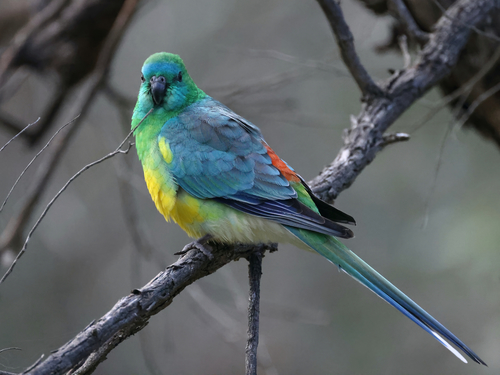
Red-rumped Parrot
The Red-rumped Parrot (*Psephotus haematonotus*) is a vibrant and relatively common bird species native to southeastern Australia. Known for its striking sexual dimorphism, the male boasts a bright green plumage with a distinctive red rump, while the female is a more subdued olive-green. This parrot plays a vital role in its ecosystem as a seed disperser and is often found in open woodlands and grasslands. It holds no particular cultural significance beyond being a popular aviary bird.
25-28 cm
Length
38-42 cm
Wingspan
Least Concern
Conservation Status
Distribution
Southeastern Australia, primarily in New South Wales, Victoria, and parts of South Australia and Queensland. They are generally non-migratory, but some local movements may occur in response to food availability.
Lifespan
Up to 15 years in the wild, potentially longer in captivity.
Red-rumped Parrot's Habitat
Habitat Types
Open woodlands, Grasslands, Savannas, Agricultural areas, Urban parks and gardens
Climate Zones
Temperate, Subtropical
Adaptations
Their strong beaks are adapted for cracking seeds and nuts, a staple of their diet. They are also well-adapted to ground foraging, with strong legs and feet for walking and running.
Variations
Two subspecies are generally recognized: *P. h. haematonotus* (eastern) and *P. h. caeruleus* (northwestern, with a bluer tinge).
Appearance
Breeding Plumage
Minimal difference; breeding males may have slightly brighter coloration.
Seasonal Feather Changes
No significant seasonal variations.
Sex Based Plumage Differences
Pronounced. Males: bright green with a red rump, yellow belly, and blue wing patches. Females: duller olive-green with a paler rump and less prominent markings.
Notable Features
Distinctive red rump on males, Long, tapered tail, Strong, hooked beak
Diet and Feeding
Primary Foods
Seeds, Grasses, Herbs, Fruits, Occasionally insects
Foraging Behavior
Primarily ground feeders, often seen foraging in small flocks. They use their beaks to crack seeds and their feet to hold food items.
Specializations
Their strong beaks are specialized for efficiently cracking a wide variety of seeds.
Seasonal Diet Variations
Diet may shift slightly depending on seasonal availability of seeds and fruits. They may consume more insects during the breeding season to provide protein for chicks.
Behavior
Social Structure
Usually found in pairs or small flocks, especially outside the breeding season. Larger flocks may form at abundant food sources.
Communication
Melodious whistling calls, Chattering calls, Visual displays (head bobbing, tail fanning)
Migration
Generally non-migratory, but may undertake local movements in response to food availability or drought conditions.
Territorial or Group Behaviors
Males are territorial during the breeding season, defending the area around the nest. Outside of breeding, they are relatively social.
Conservation
Threats
Habitat loss (clearing of woodlands), Competition with introduced species, Predation by cats and foxes, Illegal trapping for the pet trade (although less common now)
Protection Programs
Habitat restoration initiatives, Provision of nest boxes in some areas
Local National Laws
Protected under wildlife legislation in all Australian states where it occurs.
Population Trend
Stable
Population Estimates
While precise figures are difficult to obtain, the population is considered to be large and widespread.
Interesting Facts
They are known for their swift, undulating flight.
This flight pattern helps them evade predators and navigate through their woodland habitat.
The red rump of the male is only visible during flight or when displaying.
This allows for camouflage when foraging on the ground.
Red-rumped Parrots can become quite tame in areas where they are accustomed to humans.
This makes them popular visitors to parks and gardens.
Faqs about Red-rumped Parrot
Can Red-rumped Parrots be kept as pets?
Yes, they are relatively common aviary birds, but require appropriate licensing in some areas. They need a spacious aviary and a varied diet.
Are Red-rumped Parrots noisy?
They have a range of calls, some of which can be quite loud, especially during breeding season. However, their calls are generally considered pleasant.
What should I do if I find an injured Red-rumped Parrot?
Contact a local wildlife rescue organization or veterinarian for advice. Do not attempt to handle the bird unless instructed to do so.
Copyright @ Nature Style Limited. All Rights Reserved.
 English
English